So you just came back from the pet store and got inspired to research stuff you can’t usually see there?

Seeing extremely rare types of Betta fish in person is very unlikely for most of us.
So I went ahead and gathered some pictures of those for you in this post.
In terms of rarity, Betta fish breeds can be classified into two major categories:
- Uncommon colors and patterns
- Uncommon tail and fin types
Most of these Betta varieties will be very expensive and difficult to source for the regular aquarist.
Anyway, let me show you the 9 rarest and, presumably, most beautiful Betta fish in the world.
9 Extremely uncommon types of Betta fish
The Betta fish is fairly common and well-known, but many more exotic and unique types exist past what’s available in your local pet store.
So after some research and time studying them, I came across these 9 specimens that most people will never even get a chance to see.
Have a peek at the extremely rare types of Betta fish that only a few have seen in person:
1. King of Blue Eyes Avatar (designer breed)

by CRAZYHERMITCRAB
- Uncommon trait: Color
- Availability: Scarce
Starting strong is the King of Blue Eyes Avatar Betta fish. This gorgeously colored fish is black with large patterns of light blue that are so bright they appear to be glowing.
This Betta got its name because you guessed it, they have blue eyes and their colors are reminiscent of a mythical creature that can be found in the popular movie franchise Avatar. Unlike a few other entries on this list, the King of Blue Eyes Avatars are scarce to find but not impossible.
There are a couple of places online that sell this unique Betta, but you will have to pay quite a bit to get one.
2. King of Gold Dragon (designer breed)
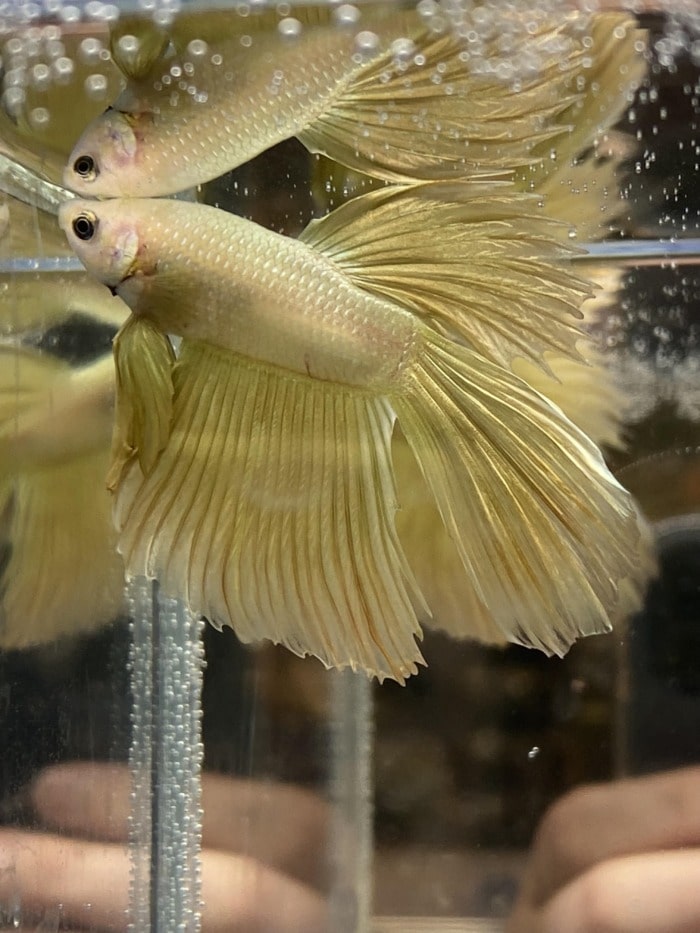
by AyaPrimrose
- Uncommon trait: Color
- Availability: Scarce
The King of Gold Dragon Betta has a color so uniquely appealing that most people might question if it’s real or not. This type of Betta is named appropriately for the yellow and orange tones that make it appear as if it’s made of gold.
If you want a rare Betta that seems to radiate a royal and expensive vibe, this one is perfect for you.
When searching for a place to buy this Betta, it was fairly hard to find one, but there are a few stores that offer this uncommon fish.
As is the case with most rare Bettas, the King of Gold Dragon Betta is generally found in places like Thailand and Laos.
3. True solid green

by Junne
- Uncommon trait: Color
- Availability: Technically it does not exist
Most of the fish on this list are not found in nature but are selectively bred to create rare and desirable traits that have not been seen before.
This is the case with the true solid green Betta.
People have worked to create a fish that was entirely green in color with little to no other variations, and while they got close, it has been said that true solid green Bettas do not exist.
The closest option to this would be a turquoise-colored Betta with reflections of green in its scales.
Their body shape is typical of that of common Bettas, the only difference is the distinctive color they produce.
4. Kachen Worachai’s Betta
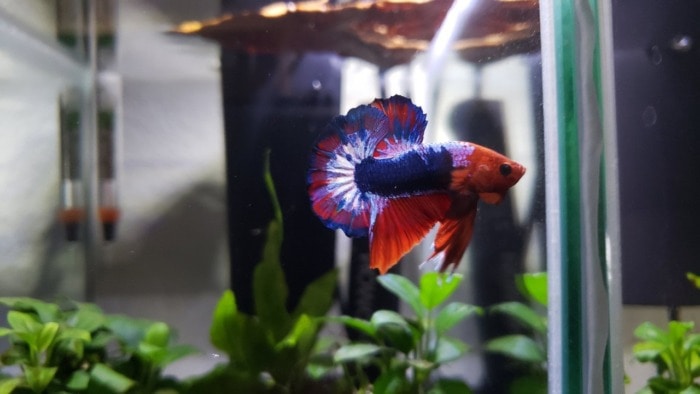
by FengTimo
- Uncommon trait: Colors and color patterns
- Availability: One of a kind
The Kachen Worachai Betta is a very popular and rare fish that resembles the colors of the Thai flag.
As a native fish to Thailand, many breeders there consider it an honor to breed a Betta with the flag’s coloration.
Though many attempts have been made to recreate patterns in this way, only a few have been successful.
Kachen Worachai is the name of the person that has managed to do it perfectly.
The Thai flag Betta should have a balanced mixture of red, white, and blue on its body with variations of the three mingled throughout.
The fins on the Kachen Worachai Betta are also a bit uncommon as well.
Other Bettas typically have long, billowy tails and fins, while the Kachen Worachai one has shorter fins that are closer to its body.
Keep in mind that this is one of the most expensive Bettas you can buy, so if you plan to get one, you might want to save up. For a list of other expensive Betta breeds, click the link in the previous sentence.
5. True solid purple
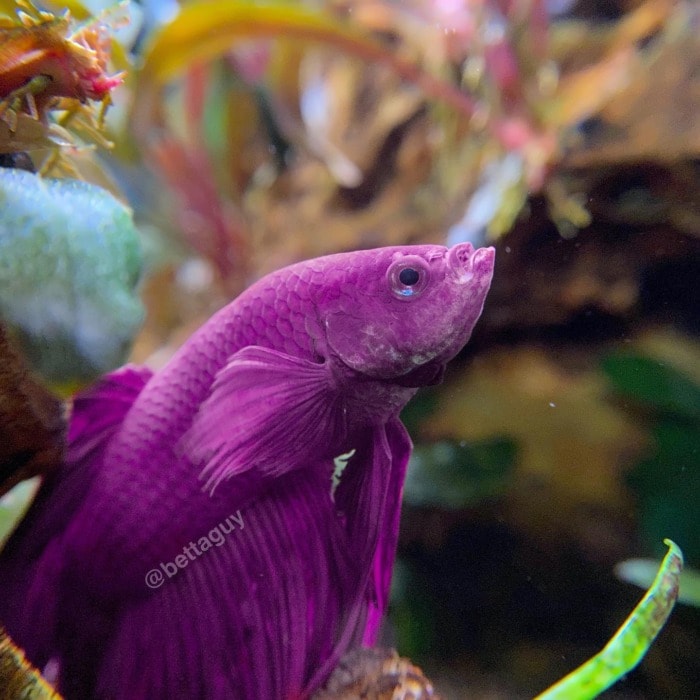
- Uncommon trait: Color
- Availability: Impossible to get
Believe it or not, the true solid purple Betta species does exist, but the chances of seeing one, let alone owning one, are slim to none.
Experts in the field have said purple is the rarest color to achieve when breeding Bettas.
Some may get pretty close but the colors are not truly purple when shined under a light.
True purple Bettas will remain the same color regardless of changes in lighting.
Since this color is so difficult to achieve, the demand for true purple Betta fish is very high.
If you happen to come across one (which is nearly impossible), keep in mind that it will be quite expensive to order.
6. Marble / Koi Betta

by weebro55
- Uncommon trait: Colors
- Availability: Not exactly rare, but they’re not readily available everywhere
The Koi Betta, also known as a Marble Betta, is another selectively bred fish with a color variety that resembles that of a Koi fish.
The color patterns of Marble Bettas can typically be a mix of milky white, orange, red, black, and sometimes even pink, the same colors you can find in a typical Koi.
Their fins and body types are still similar to short-tailed Bettas, but this may change depending on how they are bred and if they’ve developed new qualities.
Male Koi Bettas typically have brighter colors for attraction while the colors of females are duller. This type of fish isn’t the most requested or popular amongst rare Bettas, but it is still hard to come across if you’re looking to buy one.
Author’s note: A cool fact about these fish is that they have been known to completely change colors or make their current colors more vibrant. This happens randomly and more than one time during their lifetime. For more information on the interesting color-changing feature of Marble Betta fish, click here.
7. Spadetail
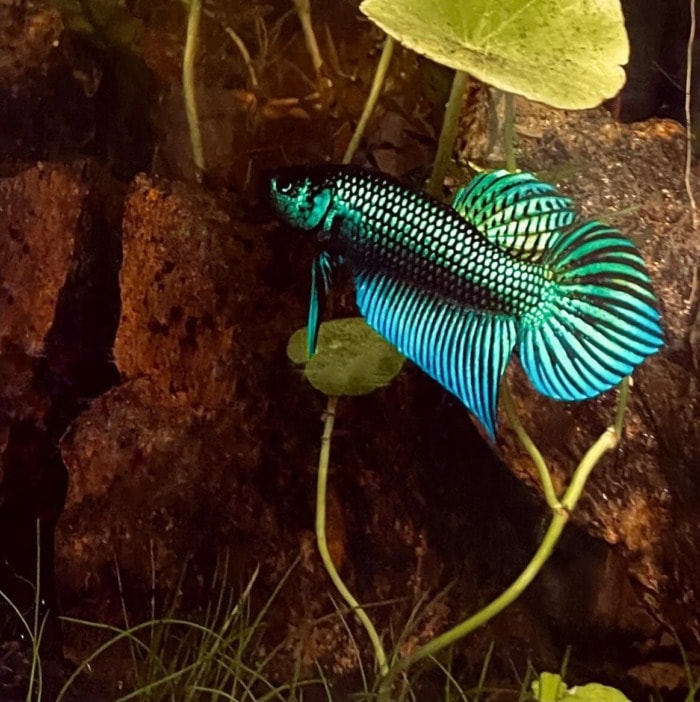
by charm_strange
- Uncommon trait: Tail and fins
- Availability: Extremely rare
This next fish on this list is said to be one of the prettiest Bettas out there due to the unique shape of their tail and the variety of colors they come in.
As you can probably already tell by their name, the Spadetail Betta has a type of tail that resembles the spade shape found in regular playing cards.
This Betta’s fins are also shaped a little differently with smoother edges that are wider at the base.
Spadetail Bettas used to be more available many years ago, but recently, they have become much harder to obtain.
However, if you do happen to find one, their price is surprisingly affordable.
8. Designer Yellow-tail Wild Splendens
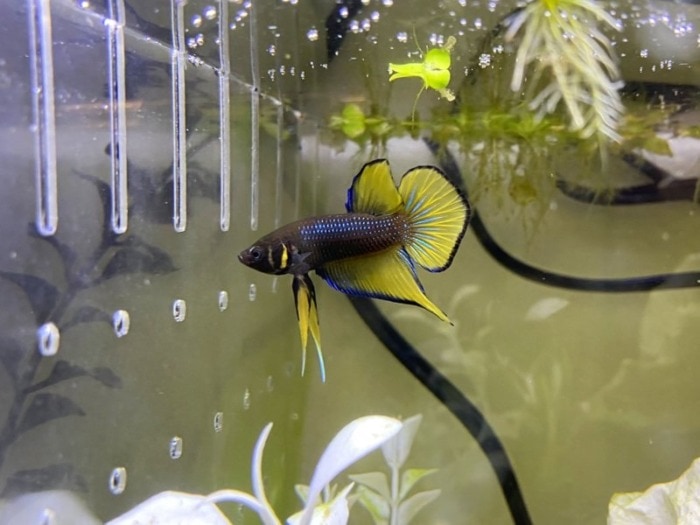
by Dewclaw83
- Uncommon trait: Color pattern
- Availability: Scarce but possible to get if you know where to look
When you think of wild Bettas typically found in nature, their colors are usually variations of browns and greys to help them better blend into their environment.
The designer yellow-tail wild has an exotic look with a translucent yellow-hued tail.
Its fins are round, and its body is vibrant with color variations of blues, yellows, and browns.
The price of these rare Bettas is very manageable for anyone interested in getting one.
Don’t get me wrong though, these types of fish are rare, but they are much easier to find online than others on this list.
Author’s note: The fish you see in the picture was sourced from Frank’s Bettas who I recommend you check out. And for the record, I’m not sponsored by him or anything – I just like his stock.
9. The rare “fantail” mutation – Plakat fantail Betta
- Uncommon trait: Double-fused Caudal tail
- Availability: Unicorn status
The defining feature of the fantail mutation Betta is that their two caudal fins are side by side and joined at a small point at the top of their tail.
This fish is so rare that there is little to no information on them.
The Plakat Faintail Betta has been described as the rarest in the world, but there is actual evidence that they do exist. Here’s a video of the fish:
If you are somehow able to find someone that has successfully bred them, you should expect to pay a pretty high price to get one.
It would be close to a miracle to find one at all.
Although Fantail Bettas have an uncommon mutation, it does not hurt them or affect them negatively in any way.
Author’s note: Fantail Bettas are given their name due to their similarity to the fantail goldfish in appearance.
Where and how can you source rare Bettas with beautiful colors?

by DLRX3
If you want to order one of these exotic little fish, just be aware that it won’t be easy.
There are only two ways to obtain good quality, rare Bettas:
- through a reputable, highly specialized breeder;
- directly from someone in Thailand or similar regions.
I understand that importing live fish can be controversial due to the stress it puts on them.
The higher demand for this also potentially creates unethical breeding programs.
However, there’s a way to do it right.
Ordering live fish from abroad can prove to be a bit confusing if you’re doing it for the first time. Fortunately, there are the transhippers! A transhipper is an intermediate person or organization that receives your order from abroad, handles all the documents, and then ships the goods to you personally.
To better understand the process, here are a few steps to help you know what to expect when ordering rare Betta fish from abroad:
- Find a reliable seller that has what you want. It’s a good idea to ask about photos of the fish you want to get.
This is to confirm that your new Betta is healthy.
- Find the closest transhipper to you and inform the seller. Sellers typically have lists with transhippers from all around the world.
The seller should immediately be able to confirm they are familiar with your transhipper.
- Pay each party. Pay the seller for your new Betta and pay the transhipper any shipping costs.
Remember this is international shipping – the costs may be a little higher.
- Receive confirmation of the arrival date. You can obviously discuss this with the seller so that it’s convenient for both of you.
- Inform the transhipper about making the purchase, the arrival date, etc. At this point, they will likely require some more information from you to fill in the shipping papers.
Wait for a transhipper notification that lets you know the fish is being transported from one boat to the next.
- Pay the transhipper to receive your new fish when it arrives. “Wait, I already paid the shipping costs, didn’t I?”
You did.
This payment is to get the Betta shipped from the transhipper to you personally (not internationally).
It’s usually a really small fee, but if the transhipper happens to be close by to you, you can just pick the fish yourself.
Obviously, you should have a 5-gallon fish tank set up and ready for the new fish. Here’s a checklist with all the things you’d need to do it, in case you’re new to this.
My advice – Should you try to get a rare Betta?
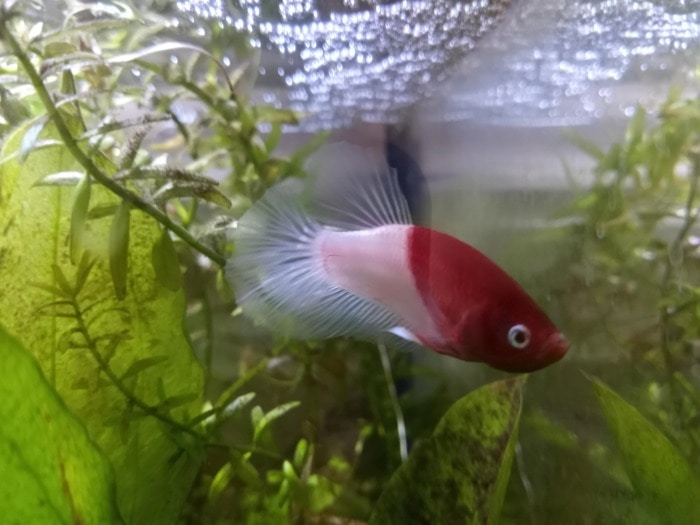
by cutebettafish101
Purchasing rare Betta fish should probably be left to people that have at least some experience in the hobby.
That’s because it’s very likely these fish were bred in soft water (what Bettas naturally live in).
Moving fish from soft to hard water can put immense stress on them and I know most from the inexperienced aquarium owners would use hard tap water for their tanks. Maintaining soft water in an aquarium is somewhat difficult if you’re a complete beginner in fishkeeping.


